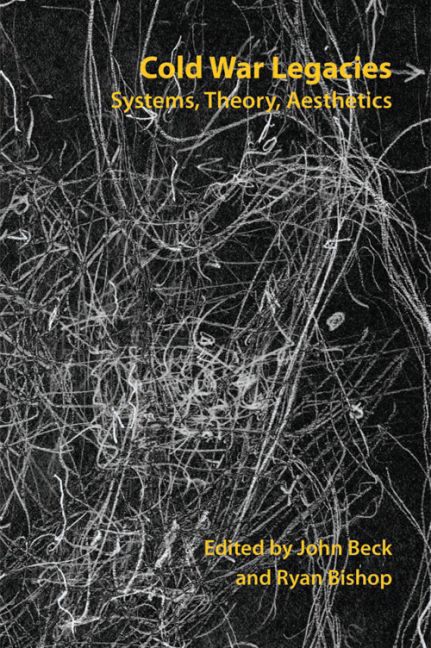Book contents
- Frontmatter
- Contents
- List of Figures
- Series Editors’ Preface
- Acknowledgements
- Notes on Contributors
- Introduction: The Long Cold War
- I PATTERN RECOGNITION
- II THE PERSISTENCE OF THE NUCLEAR
- III UBIQUITOUS SURVEILLANCE
- IV PERVASIVE MEDIATIONS
- 11 Notes from the Underground: Microwaves, Backbones, Party Lines and the Post Offi ce Tower
- 12 Insect Technics: War Vision Machines
- 13 Overt Research
- 14 Smart Dust and Remote Sensing: The Political Subject in Autonomous Systems
- Index
13 - Overt Research
from IV - PERVASIVE MEDIATIONS
Published online by Cambridge University Press: 10 May 2017
- Frontmatter
- Contents
- List of Figures
- Series Editors’ Preface
- Acknowledgements
- Notes on Contributors
- Introduction: The Long Cold War
- I PATTERN RECOGNITION
- II THE PERSISTENCE OF THE NUCLEAR
- III UBIQUITOUS SURVEILLANCE
- IV PERVASIVE MEDIATIONS
- 11 Notes from the Underground: Microwaves, Backbones, Party Lines and the Post Offi ce Tower
- 12 Insect Technics: War Vision Machines
- 13 Overt Research
- 14 Smart Dust and Remote Sensing: The Political Subject in Autonomous Systems
- Index
Summary
Neal White is an artist whose work is broadly concerned with the production of knowledge and the physical and immaterial spaces simultaneously occupied and generated by various forms of scientific, technological, military and artistic research. Many of his projects involve investigations of institutional spaces, including archives, laboratories and installations, and the practices and values that produce them. White's work, then, is often positioned inside, adjacent to, or even resolutely outside (in the case of projects concerned with securitised or secret sites) wider networks of scientific and technological research. Key to White's work is collaboration and experiment, practices that are fundamental to science, technology and engineering, and increasingly a dominant aspect of contemporary art. Since 2004, his collaborative practice with the Office of Experiments has led a series of projects focused on experimental forms of research. In the following discussion with John Beck, White discusses the notion of art-as-research, the importance of collaboration and site-specificity, and a number of ways in which his practice has engaged with the legacies of Cold War infrastructure in Europe and the UK.
John Beck: Could you tell me something about the Office of Experiments? What is it and what does it do?
Neal White: The Office of Experiments (OoE) is a collective that reflects the shift that some artists have made away from individual studio practice and toward collaboration, not just with other artists but with others who are often concealed in the process of art making. The OoE is a network, research structure, production space, and a site for experimental encounters. It was conceived during a project with Danish architects N55 in 2004, and then formalised as a nonlegal entity using the ideas of artist John Latham on event structures and the work of historian of science Hans-Jörg Rheinberger.
JB: Perhaps we could unpack these influences a little. First of all, could you say a little more about the influence of Latham?
NW: John Latham was a British conceptual artist (1922–2006) and I met him in 2003, after an introduction concerning my critical interest in the relationships between artists engaging with power structures in science. He was strongly taken by a book I had published with author Lawrence Norfolk that revisits the famous forty-five frames of W. K. L. Dickson's Record of a Sneeze(1894) using laser, video and computer technologies.
- Type
- Chapter
- Information
- Cold War LegaciesLegacy, Theory, Aesthetics, pp. 252 - 272Publisher: Edinburgh University PressPrint publication year: 2016

